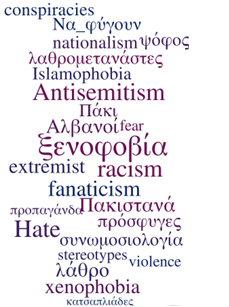
Verbal Aggression (VA) constitutes an important component in the study of xenophobia, since xenophobic attitudes constitute the background of verbal aggressive manifestations against foreigners and their defamation. The close relation of VA with xenophobia is also demonstrated by the hate speech literature [1]. Identifying hate speech consistently is difficult and often yields the paradox that each person seems to have an intuition for what hate speech is, but rarely are two people’s understanding the same [2]. DeMoLiSH approaches hate speech in terms of specific types of verbal attacks following a data driven and linguistically inspired VA analysis framework [3], where VA messages are classified based on: (a) their focus (distinguishing between utterances focusing on the target’s attributes, and utterances focusing on the attacker’s thoughts), (b) the type of linguistic weapon used for the attack (e.g. evaluative language, slang), and (c) the content of the attack (e.g. threats/calls for physical violence or for deportation). This fine-grained classification schema allows for in-depth understanding and interpretation of online xenophobic messages as opposed to typical binary distinctions between hateful and non-hateful or offensive content.
References
[1] Sanguinetti et al. 2018 Sanguinetti, M. et al. (2018). “An Italian Twitter corpus of hate speech against immigrants”. In Proceedings of LREC 2018.
[2] Saleem H. M., Dillon K., Benesch S. and Ruths, D. (2017). “A web of hate: tackling hateful speech in online social spaces”. In Proceedings of LREC 2016.
[3] Pontiki, M., Papanikolaou, K. and Papageorgiou, H. (2018). “Exploring the predominant targets of xenophobia-motivated behavior: A longitudinal study for Greece”. In Proceedings of LREC 2018.
